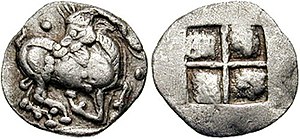
Back Еге Bulgarian Eges (Macedònia) Catalan Aigai French איגאי (מקדוניה) HE Aigai, Makedonia ID Aegae Latin Ајга Macedonian Aigai Maltese Archeologische site van Aigai Dutch Эги (Македония) Russian
Αἰγαί | |
 Coinage of Aegae towards the end of the reign of Amyntas I, under Achaemenid Macedonia, circa 510–480 BC. Goat kneeling right, head reverted; pellet above and before / Quadripartite incuse square. |
Aegae or Aigai (Ancient Greek: Αἰγαί), also Aegeae or Aigeai (Αἰγέαι) was the original capital of the Macedonians, an ancient kingdom in Emathia in northern Greece. Currently the site falls within the town of Vergina.[1][2]
The seat of government was later transferred to Pella, which was located on a coastal waterway of the Thermaic Gulf. The current plain of central Macedonia did not yet exist, its area being divided between Lake Ludias and marshland. The plain was created by draining and infilling in modern times. The old capital remained the "hearth"[3] of the Macedonian kingdom and the burial place for their kings. These were the Temenid dynasty, which descended from the Perdiccas.
The body of Alexander the Great was to have reposed at Aegae,[4] where his father Philip II of Macedon fell by the hand of Pausanias of Orestis[5] but it was taken to Memphis through the intrigues of Ptolemy I Soter.
The recently excavated palace is considered to be not only the biggest but, together with the Parthenon, one of the most significant buildings of classical Greece.[6]
In 1996, the archaeological site of Aigai was inscribed on the UNESCO World Heritage List because of its monumental significance in Western civilization and exceptional architecture.[7]
- ^ Lund University. Digital Atlas of the Roman Empire.
- ^ Richard Talbert, ed. (2000). Barrington Atlas of the Greek and Roman World. Princeton University Press. p. 50, and directory notes accompanying. ISBN 978-0-691-03169-9.
- ^ ἑστία, Diod. Excerpt. p. 563
- ^ Pausanias (1918). "6.3". Description of Greece. Vol. 1. Translated by W. H. S. Jones; H. A. Ormerod. Cambridge, Massachusetts; London: Harvard University Press; William Heinemann – via Perseus Digital Library.
- ^ Diodorus Siculus. Bibliotheca historica (Historical Library). Vol. 16.91, 92.
- ^ "Αιγές (Βεργίνα) | Museum of Royal Tombs of Aigai -Vergina". www.aigai.gr. Archived from the original on 2018-12-29. Retrieved 2020-01-10.
- ^ "Archaeological Site of Aigai (modern name Vergina)". UNESCO World Heritage Convention. United Nations Educational Scientific and Cultural Organization. Retrieved 25 November 2022.
© MMXXIII Rich X Search. We shall prevail. All rights reserved. Rich X Search